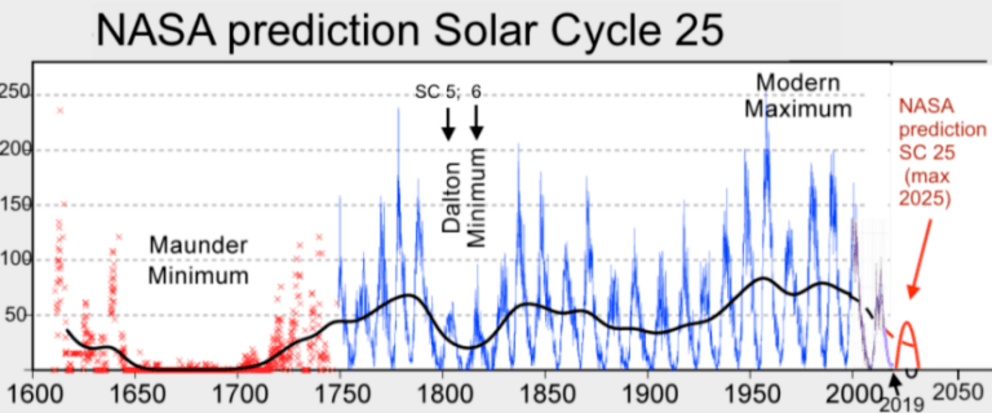Acclaimed Israeli astrophysicist suggests the Sun drives Earth’s climate, not CO2
Nir Shaviv is an Israeli astrophysicist and chairman of Jerusalem’s Hebrew University’s physics department. He says that his research, and that of colleagues, suggests that rising CO2 levels play only a minor role in earth’s climate compared to the influence of the sun and cosmic radiation.
“Global warming clearly is a problem, though not in the catastrophic terms of Al Gore’s movies or environmental alarmists,” said Shaviv. “Climate change has existed forever and is unlikely to go away. But CO2 emissions don’t play the major role. Periodic solar activity does.”
But I thought that 97% of climate scientists agreed that human activity is the main driver of climate change?
“Only people who don’t understand science take the 97% statistic seriously,” said Shaviv. “Survey results depend on who you ask, who answers and how the questions are worded. In any case, science is not a democracy. Even if 100% of scientists believe something, one person with good evidence can still be right.”
And for anyone attempting to dismiss Shaviv’s credentials?
Well, he enrolled at Israel’s Technion University – the country’s equivalent of MIT – at the age of 13 and earned an MA while serving in the Israel Defense Force’s celebrated 8200 Intelligence unit. He returned to Technion, where he earned his doctorate, afterward completing post-doctoral work at California Institute of Technology and the Canadian Institute for Theoretical Astrophysics. He also has been an Einstein Fellow at The Institute for Advanced Study in Princeton — we’re told to listen to the scientists, right?
But what about Shaviv’s supposed political agenda, he’s been corrupted from that angle, right?
“In American terms, I would describe myself as liberal on most domestic issues, somewhat hawkish on security,” Shaviv explained. “Nonetheless, the Trump administration’s position on global climate change is correct insofar as it rejects the orthodoxy of the United Nations Intergovernmental Panel on Climate Change (IPCC).
“Since [2003], literally billions have been spent on climate research,” Shaviv added. Yet, “the conventional wisdom hasn’t changed. The proponents of man-made climate change still ignore the effect of the sun on the earth’s climate, which overturns our understanding of twentieth-century climate change.”
He explained: “Solar activity varies over time. A major variation is roughly eleven years or more, which clearly affects climate. This principle has been generally known – but in 2008 I was able to quantify it by using sea level data. When the sun is more active, there is a rise in sea level here on earth. Higher temperature makes water expand. When the sun is less active, temperature goes down and the sea level falls – the correlation is as clear as day.
“Based on the increase of solar activity during the twentieth century, it should account for between half to two-thirds of all climate change,” he said. “That, in turn, implies that climate sensitivity to CO2 should be about 1.0 degree when the amount of CO2 doubles.”
The link between solar activity and the heating and cooling of the earth is indirect, he explained.
Galactic Cosmic Raysare a mixture of high-energy photons and sub-atomic particles accelerated toward Earth by supernova explosions and other violent events in the cosmos. Solar Cosmic Raysare the same, though their source is the sun.
Both Galactic and Solar Cosmic rays hitting Earth’s atmosphere create aerosols which, in turn, seed clouds (Svensmark et al) — making them a crucial player in earth’s weather and climate.
During solar minimum, like the one we’re entering now, the sun’s magnetic field weakens and the outward pressure of the solar wind decreases. This allows more cosmic rays from deep space to penetrate our planet’s atmosphere and nucleate more clouds.
“Clouds are the Earth’s sunshade, and if cloud cover changes for any reason, you have global warming — or global cooling.” — Roy W. Spencer Ph.D.
“Today we can demonstrate and prove the sun’s effect on climate based on a wide range of evidence, from fossils that are hundreds of millions of years old to buoy readings to satellite altimetry data from the past few decades,” Shaviv explained. “We also can reproduce and mimic atmospheric conditions in the laboratory to confirm the evidence.
“All of it shows the same thing, the bulk of climate change is caused by the sun via its impact on atmospheric charge, which means that most of the warming comes from nature — a freshman physics student can see this.
“Our findings are very inconvenient for conventional wisdom. We know that there have been very large variations of climate in the past that have little to do with the burning of fossil fuels. A thousand years ago the earth was as warm as it is today. During the Little Ice Age three hundred years ago the River Thames froze more often. In the first and second IPCC reports these events were mentioned. In 2001 they disappeared. Suddenly no mention of natural warming, no Little Ice Age. The climate of the last millennium was presented as basically fixed until the twentieth century. This is a kind of Orwellian cherry-pickingto fit a pre-determined narrative.”
Shaviv says that he has accepted no financial supportfor his research from the fossil fuel industry.
“The real problem is funding from funding agencies like the National Science Foundation because these proposals have to undergo review by people in a community that ostracizes us,” he said, because of his non-conventional viewpoint.
“Global warming is not a purely scientific issue any more,” he said. “It has repercussions for society. It has also taken on a moralistic, almost religious quality. If you believe what everyone believes, you are a good person. If you don’t, you are a bad person. Who wants to be a sinner?”
In Shaviv’s view, the worldwide crusade to limit and eventually ban fossil fuels “comes with real world social and economic consequences.” Switching to more costly energy sources will drive industry from more industrialized countries to poorer countries that can less afford wind turbines and solar panels.
“It may be a financial sacrifice the rich are willing to make,” Shaviv added. “Even in developed countries the pressure to forego fossil fuel puts poor people in danger of freezing during the winter for lack of affordable home heating. The economic growth of third world countries will be inhibited if they cannot borrow from the World Bank to develop cheap fossil-based power plants. These are serious human problems in the here and now, not in a theoretical future.”
And unfortunately the cold timesare returning, in line with historically low solar activity.
Even NASA agrees, in part at least, with their SC25 forecast revealing it will be “the weakest of the past 200 years”:

The time to prepare is now.
Grand Solar Minimum + Pole Shift
Nir Shaviv’s alternative viewpoints were originally posted in a Forbes article on Aug 9th entitled “Global Warming? An Israeli Astrophysicist Provides Alternative View That Is Not Easy To Reject” written by Doron Levin (linked here) — that was, until the publication censored the article just a few hours after going live“for failing to meet our editorial standards” — 1984 is upon us — the truth shouldn’t be this hard to spread.

